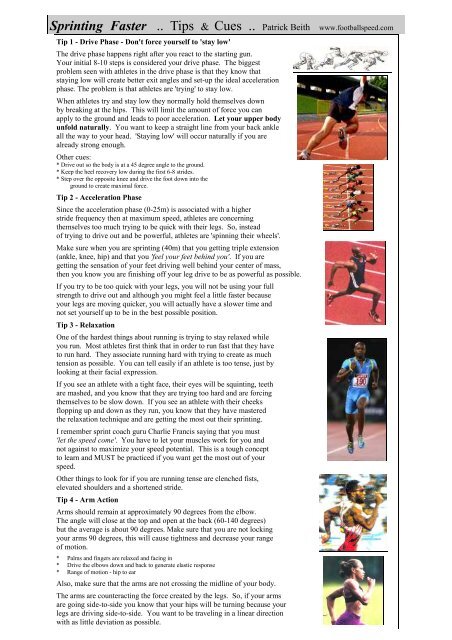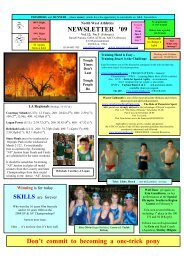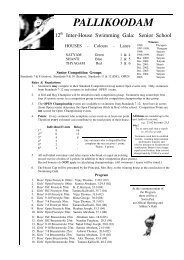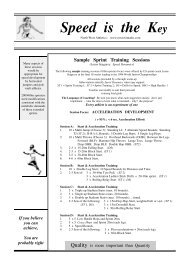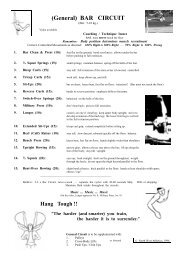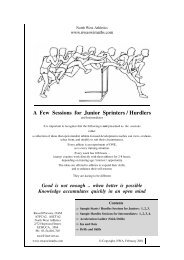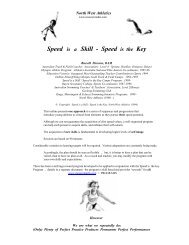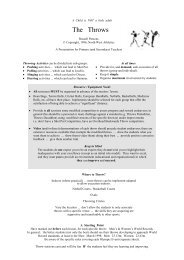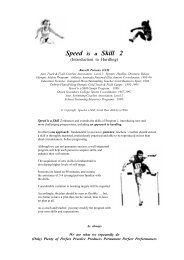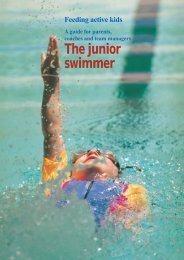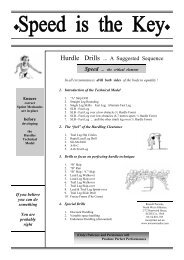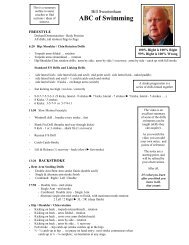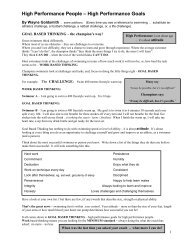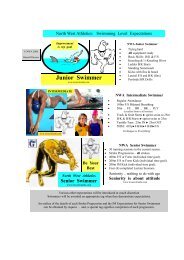Sprinting Faster .. Tips & Cues .. Patrick Beith - North West Athletics
Sprinting Faster .. Tips & Cues .. Patrick Beith - North West Athletics
Sprinting Faster .. Tips & Cues .. Patrick Beith - North West Athletics
You also want an ePaper? Increase the reach of your titles
YUMPU automatically turns print PDFs into web optimized ePapers that Google loves.
<strong>Sprinting</strong> <strong>Faster</strong> .. <strong>Tips</strong> & <strong>Cues</strong> .. <strong>Patrick</strong> <strong>Beith</strong><br />
Tip 1 - Drive Phase - Don't force yourself to 'stay low'<br />
The drive phase happens right after you react to the starting gun.<br />
Your initial 8-10 steps is considered your drive phase. The biggest<br />
problem seen with athletes in the drive phase is that they know that<br />
staying low will create better exit angles and set-up the ideal acceleration<br />
phase. The problem is that athletes are 'trying' to stay low.<br />
When athletes try and stay low they normally hold themselves down<br />
by breaking at the hips. This will limit the amount of force you can<br />
apply to the ground and leads to poor acceleration. Let your upper body<br />
unfold naturally. You want to keep a straight line from your back ankle<br />
all the way to your head. 'Staying low' will occur naturally if you are<br />
already strong enough.<br />
Other cues:<br />
* Drive out so the body is at a 45 degree angle to the ground.<br />
* Keep the heel recovery low during the first 6-8 strides.<br />
* Step over the opposite knee and drive the foot down into the<br />
ground to create maximal force.<br />
Tip 2 - Acceleration Phase<br />
Since the acceleration phase (0-25m) is associated with a higher<br />
stride frequency then at maximum speed, athletes are concerning<br />
themselves too much trying to be quick with their legs. So, instead<br />
of trying to drive out and be powerful, athletes are 'spinning their wheels'.<br />
Make sure when you are sprinting (40m) that you getting triple extension<br />
(ankle, knee, hip) and that you 'feel your feet behind you'. If you are<br />
getting the sensation of your feet driving well behind your center of mass,<br />
then you know you are finishing off your leg drive to be as powerful as possible.<br />
If you try to be too quick with your legs, you will not be using your full<br />
strength to drive out and although you might feel a little faster because<br />
your legs are moving quicker, you will actually have a slower time and<br />
not set yourself up to be in the best possible position.<br />
Tip 3 - Relaxation<br />
One of the hardest things about running is trying to stay relaxed while<br />
you run. Most athletes first think that in order to run fast that they have<br />
to run hard. They associate running hard with trying to create as much<br />
tension as possible. You can tell easily if an athlete is too tense, just by<br />
looking at their facial expression.<br />
If you see an athlete with a tight face, their eyes will be squinting, teeth<br />
are mashed, and you know that they are trying too hard and are forcing<br />
themselves to be slow down. If you see an athlete with their cheeks<br />
flopping up and down as they run, you know that they have mastered<br />
the relaxation technique and are getting the most out their sprinting.<br />
I remember sprint coach guru Charlie Francis saying that you must<br />
'let the speed come'. You have to let your muscles work for you and<br />
not against to maximize your speed potential. This is a tough concept<br />
to learn and MUST be practiced if you want get the most out of your<br />
speed.<br />
Other things to look for if you are running tense are clenched fists,<br />
elevated shoulders and a shortened stride.<br />
Tip 4 - Arm Action<br />
Arms should remain at approximately 90 degrees from the elbow.<br />
The angle will close at the top and open at the back (60-140 degrees)<br />
but the average is about 90 degrees. Make sure that you are not locking<br />
your arms 90 degrees, this will cause tightness and decrease your range<br />
of motion.<br />
* Palms and fingers are relaxed and facing in<br />
* Drive the elbows down and back to generate elastic response<br />
* Range of motion - hip to ear<br />
Also, make sure that the arms are not crossing the midline of your body.<br />
The arms are counteracting the force created by the legs. So, if your arms<br />
are going side-to-side you know that your hips will be turning because your<br />
legs are driving side-to-side. You want to be traveling in a linear direction<br />
with as little deviation as possible.<br />
www.footballspeed.com
Tip 5 - Hands: Open vs. Closed<br />
Cueing the hands can be a touchy subject. Some coaches believe that<br />
having your hands open is the best way while others like a closed hand<br />
for their athletes to use while running.<br />
First, I would look at the athlete. If they look as if their shoulders/arms<br />
are staying relaxed and aren't crossing the midline then you shouldn't<br />
cue this athlete too much with hand technique. There are so many other<br />
cues and techniques to work on than to worry about their hands if they<br />
don't seem to be causing a problem.<br />
If your athlete is not staying relaxed in their arms and shoulders then I<br />
would address then hands. Usually if the hands are wide open with the<br />
fingers and palms are straight, the forearm tends to be flexed. This<br />
causes tension of the arm and the upper arm and shoulders, and as you<br />
know, this can affect the elasticity of your muscles causing you to fight<br />
yourself as you move.<br />
The same thing can happen when you make a fist and try to run. Holding<br />
your hands clenched causes your forearms to be tight and you will run into<br />
the same problem as the 'open' hand.<br />
I teach in between both of these. You want your hands to stay relaxed.<br />
I'm sure you have heard this saying before ... ' pretend you are holding<br />
a potato chip in your hand and you don't want to break it'.<br />
You can actually feel your fingers almost bouncing up and down as you run.<br />
This is the type of relaxation that should carry to the rest of your arm up<br />
to your shoulder. Keep the hands loose, but not open.<br />
(Another thing to note is that looking at the top receivers and defensive<br />
backs, they never run with closed hands because they want their hands<br />
to be as soft as possible to catch a ball. If their hands are closed, their<br />
arms will be tight and it will take more time to open them and create<br />
the soft hands that they are looking for).<br />
Tip 6 - Stride Length<br />
We touched a little on stride frequency, now let's get into stride length.<br />
Your optimal stride length should be about 2.5-2.7 times your leg length.<br />
While optimal stride length is important, I would stay away form certain<br />
exercises to try to increase it. Excessive downhill and over speed running<br />
can actually cause problems with your running technique. If the slope going<br />
downhill is too much and if you are being pulled fast during over speed work,<br />
your legs starts to create a braking action. This is where your foot plantar flexes<br />
(toes pointed down) in front of your center of mass to try and stop that speed.<br />
So, you are fighting yourself and stopping any speed you are trying to create.<br />
This can not only cause damage to your hamstrings but can also create<br />
neuromuscular integration problems.<br />
Flexibility (dynamic ranges of motion and static stretching) and strength<br />
& power training (which also helps joint stabilization) are the best ways<br />
to reach your optimal stride length level.<br />
Tip 7 - Other <strong>Sprinting</strong> <strong>Tips</strong>/<strong>Cues</strong><br />
* Hips tall<br />
* Foot strikes on forefoot - and under the center of mass;<br />
the farther away the foot strikes away from the COM,<br />
the higher the braking force.<br />
* toe up - reduces hamstring fatigue by using the gastroc as a knee flexor<br />
* heel up<br />
* knee up<br />
* Ankle steps over the knee<br />
* Shoulders down and relaxed<br />
* Face and neck relaxed<br />
* Tight stomach, flat back, hips forward<br />
Only<br />
Plenty of<br />
Perfect<br />
Practice<br />
Produces<br />
Professional<br />
Performances<br />
Most of the technique tips link directly to those shown in<br />
Speed Dynamics: Drills for Speed<br />
<strong>Patrick</strong> offers an excellent DVD (you can inspect my copy on request): <strong>North</strong>-South Football Speed;<br />
although the advice is focused towards US football and imperial measurements, the technique tips are<br />
universal … speed is speed; the technique tips and drills shown can benefit all sports.


